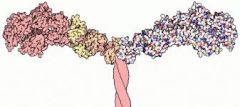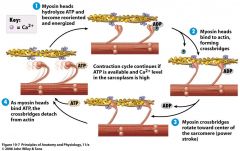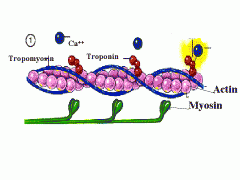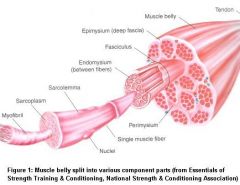![]()
![]()
![]()
Use LEFT and RIGHT arrow keys to navigate between flashcards;
Use UP and DOWN arrow keys to flip the card;
H to show hint;
A reads text to speech;
12 Cards in this Set
- Front
- Back
|
Myosin
|

Protein/Enzyme that helps react ATP into ADP and phosphate group (making it an ATPase enzyme)
Myosin uses ATP to crawl along actin rope and that generates energy Long fibrous tail and as two heads which bind to actin and ATP, which is the source of energy for muscle movement. myosin can only bind to actin when the binding sites are exposed to calcium ions THICK filament |
|
|
Actin
|

THIN filament, rope-like base that gets pulled
|
|
|
4 Steps in myosin/actin changes that result in muscle contraction
|

1. ATP binds to myosin "head" -> myosin releases actin
2. ATP -> ADP + Phosphate Group -> "cocks" myosin protein to HIGH energy conformation (state) 3. Phosphate released from myosin, releases energy from cocked position and causes myosin protein to PUSH on the actin filament. "releases the spring" 4. ADP released, returns to original state just one rung further on actin molecule Chemical energy -> mechanical energy here |
|
|
sarcomere
|
basic unit of muscle, combines into repeating segments called myofibrils.
separated by "z lines" |
|
|
myofibrils
|
tubular stretches of sarcomeres that make up muscle cells/myocytes. inside of these are myosin and actin, these are what actually do the contraction
|
|
|
tropomyosin
|

know that it is a COIL, it's coiled around actin and is "nailed" in place with troponin.
when muscle is not contracting, tropomyosin BLOCKS the myosin from crawling up the actin only way to make it unblocked is for troponin to change their shape is when there is a HIGH CALCIUM ION concentration (tropomyoSin for snake) |
|
|
troponin
|

the tropomyosin coil attaches to actin with troponin
"nails into the actin" when muscle is relaxed, the troponin keeps the tropomyosin in its coil that blocks the myosin from moving down the actin. when there is a high calcium ion concentration, the calcium ions bond to troponin and troponin moves out of the way, therefore the myosin can start walking up the actin low calcium -> troponin goes back to standard confirmation and tropomyosin blocks myosin again (tropoNIN for nine inch nails) |
|
|
skeletal muscle
|
voluntary/controllable muscle that connects to and can move a bone. what you normally think of as muscle
|
|
|
smooth muscle
|
involuntary, slow moving muscle in things like peristalsis
|
|
|
tendons connect what?
|
connects muscle to bone
|
|
|
muscle cell anatomy diagram:
tendon epi/endo-mysium perimysium myofibril fascicle sarcoplasm sarcolemma (probably more info than necessary, but glance at it) know that myo means __ and sarco means ___ |

myo = muscle
sarco = flesh endo = inner epi = outer peri = around |
|
|
because muscle cells are so long, what is special about their nucleus?
|
they have multiple nuclei to compensate for the large distances of the cell and keep the DNA nearby
|

